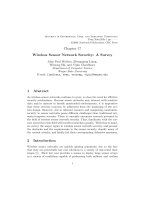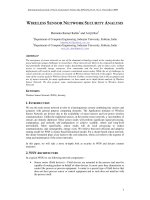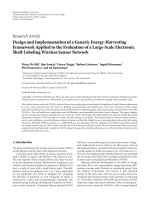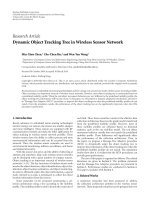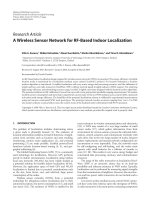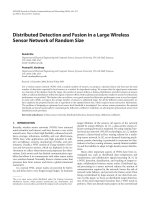wireless sensor network designs
Bạn đang xem bản rút gọn của tài liệu. Xem và tải ngay bản đầy đủ của tài liệu tại đây (3.61 MB, 410 trang )
Wireless Sensor Network
Designs
Anna Ha´
c
University of Hawaii at Manoa, Honolulu, USA
Wireless Sensor Network
Designs
Wireless Sensor Network
Designs
Anna Ha´
c
University of Hawaii at Manoa, Honolulu, USA
Copyright 2003
John Wiley & Sons Ltd, The Atrium, Southern Gate, Chichester,
West Sussex PO19 8SQ, England
Telephone (+44) 1243 779777
Email (for orders and customer service enquiries):
Visit our Home Page on www.wileyeurope.com or www.wiley.com
All Rights Reserved. No part of this publication may be reproduced, stored in a retrieval system or
transmitted in any form or by any means, electronic, mechanical, photocopying, recording, scanning or
otherwise, except under the terms of the Copyright, Designs and Patents Act 1988 or under the terms of a
licence issued by the Copyright Licensing Agency Ltd, 90 Tottenham Court Road, London W1T 4LP, UK,
without the permission in writing of the Publisher. Requests to the Publisher should be addressed to the
Permissions Department, John Wiley & Sons Ltd, The Atrium, Southern Gate, Chichester, West Sussex
PO19 8SQ, England, or emailed to , or faxed to (+44) 1243 770620.
This publication is designed to provide accurate and authoritative information in regard to the subject
matter covered. It is sold on the understanding that the Publisher is not engaged in rendering
professional services. If professional advice or other expert assistance is required, the services of a
competent professional should be sought.
Other Wiley Editorial Offices
John Wiley & Sons Inc., 111 River Street, Hoboken, NJ 07030, USA
Jossey-Bass, 989 Market Street, San Francisco, CA 94103-1741, USA
Wiley-VCH Verlag GmbH, Boschstr. 12, D-69469 Weinheim, Germany
John Wiley & Sons Australia Ltd, 33 Park Road, Milton, Queensland 4064, Australia
John Wiley & Sons (Asia) Pte Ltd, 2 Clementi Loop #02-01, Jin Xing Distripark, Singapore 129809
John Wiley & Sons Canada Ltd, 22 Worcester Road, Etobicoke, Ontario, Canada M9W 1L1
Wiley also publishes its books in a variety of electronic formats. Some content that appears
in print may not be available in electronic books.
Library of Congress Cataloging-in-Publication Data
Ha´ , Anna.
c
Wireless sensor network designs / Anna Hac.
p. cm.
Includes bibliographical references and index.
ISBN 0-470-86736-1
1. Sensor networks. 2. Wireless LANs. I. Title.
TK7872.D48.H33 2003
621.382’1 – dc22
2003057612
British Library Cataloguing in Publication Data
A catalogue record for this book is available from the British Library
ISBN 0-470-86736-1
Typeset in 11/13pt Palatino by Laserwords Private Limited, Chennai, India
Printed and bound in Great Britain by TJ International, Padstow, Cornwall
This book is printed on acid-free paper responsibly manufactured from sustainable forestry
in which at least two trees are planted for each one used for paper production.
Contents
Preface
ix
About the Author
xv
1 Networked Embedded Systems
1.1. Introduction
1.2. Object-Oriented Design
1.3. Design Integration
1.4. Design Optimization
1.5. Co-design and Reconfiguration
1.6. Java-Driven Co-design and Prototyping
1.6.1. Java-Based Co-design
1.6.2. Run-Time Management
1.6.3. Embedded Systems Platform
1.7. Hardware and Software Prototyping
1.8. Multiple Application Support
1.8.1. FPGA-Based System Architecture
1.9. Summary
Problems
Learning Objectives
Practice Problems
Practice Problem Solutions
1
1
3
4
6
9
12
13
15
17
20
23
25
27
28
28
29
29
2 Smart Sensor Networks
2.1. Introduction
2.2. Vibration Sensors
2.3. Smart Sensor Application to Condition Based Maintenance
2.4. Smart Transducer Networking
2.5. Controller Area Network
2.6. Summary
31
31
32
34
42
46
58
vi
CONTENTS
Problems
Learning Objectives
Practice Problems
Practice Problem Solutions
60
60
60
60
3 Power-Aware Wireless Sensor Networks
3.1. Introduction
3.2. Distributed Power-Aware Microsensor Networks
3.3. Dynamic Voltage Scaling Techniques
3.4. Operating System for Energy Scalable Wireless Sensor Networks
3.5. Dynamic Power Management in Wireless Sensor Networks
3.6. Energy-Efficient Communication
3.7. Power Awareness of VLSI Systems
3.8. Summary
Problems
Learning Objectives
Practice Problems
Practice Problem Solutions
63
63
65
71
75
79
81
85
95
97
97
97
98
4 Routing in Wireless Sensor Networks
4.1. Introduction
4.2. Energy-Aware Routing for Sensor Networks
4.3. Altruists or Friendly Neighbors in the Pico Radio Sensor Network
4.3.1. Energy-Aware Routing
4.3.2. Altruists or Friendly Neighbors
4.3.3. Analysis of Energy Aware and Altruists Routing Schemes
4.4. Aggregate Queries in Sensor Networks
4.4.1. Aggregation Techniques
4.4.2. Grouping
4.5. Summary
Problems
Learning Objectives
Practice Problems
Practice Problem Solutions
101
101
102
109
111
114
116
120
125
133
135
136
136
137
137
5 Distributed Sensor Networks
5.1. Introduction
5.2. Bluetooth in the Distributed Sensor Network
5.2.1. Bluetooth Components and Devices
5.2.2. Bluetooth Communication and Networking
5.2.3. Different Technologies
5.3. Mobile Networking for Smart-Dust
5.3.1. Smart-Dust Technology
5.3.2. Communication and Networking
5.4. Summary
Problems
Learning Objectives
141
141
142
144
146
151
154
154
159
162
163
163
CONTENTS
vii
Practice Problems
Practice Problem Solutions
163
163
6 Clustering Techniques in Wireless Sensor Networks
6.1. Introduction
6.2. Topology Discovery and Clusters in Sensor Networks
6.2.1. Topology Discovery Algorithm
6.2.2. Clusters in Sensor Networks
6.2.3. Applications of Topology Discovery
6.3. Adaptive Clustering with Deterministic Cluster-Head Selection
6.4. Sensor Clusters’ Performance
6.4.1. Distributed Sensor Processing
6.5. Power-Aware Functions in Wireless Sensor Networks
6.5.1. Power Aware Software
6.6. Efficient Flooding with Passive Clustering
6.6.1. Passive Clustering
6.7. Summary
Problems
Learning Objectives
Practice Problems
Practice Problem Solutions
165
165
166
169
171
177
181
185
187
192
196
198
203
207
208
208
209
209
7 Security Protocols for Wireless Sensor Networks
7.1. Introduction
7.2. Security Protocols in Sensor Networks
7.2.1. Sensor Network Security Requirements
7.2.2. Authenticated Broadcast
7.2.3. Applications
7.3. Communication Security in Sensor Networks
7.4. Summary
Problems
Learning Objectives
Practice Problems
Practice Problem Solutions
213
213
214
216
219
223
225
230
230
230
231
231
8 Operating Systems for Embedded Applications
8.1. Introduction
8.2. The Inferno Operating System
8.3. The Pebble Component-Based Operating System
8.3.1. Protection Domains and Portals
8.3.2. Scheduling and Synchronization
8.3.3. Implementation
8.3.4. Embedded Applications
8.4. Embedded Operating System Energy Analysis
8.5. Summary
Problems
Learning Objectives
235
235
236
242
246
250
253
258
264
270
271
271
viii
CONTENTS
Practice Problems
Practice Problem Solutions
9 Network Support for Embedded Applications
9.1. Introduction
9.2. Bluetooth Architecture
9.3. Bluetooth Interoperability with the Internet and Quality of Service
9.4. Implementation Issues in Bluetooth-Based Wireless Sensor Networks
9.5. Low-Rate Wireless Personal Area Networks
9.6. Data-Centric Storage in Wireless Sensor Networks
9.7. Summary
Problems
Learning Objectives
Practice Problems
Practice Problem Solutions
272
272
275
275
277
283
288
297
306
314
315
315
315
316
10 Applications of Wireless Sensor Networks
10.1. Introduction
10.2. Application and Communication Support for Wireless Sensor Networks
10.3. Area Monitoring and Integrated Vehicle Health Management Applications
10.3.1. Development Platform
10.3.2. Applications
10.4. Building and Managing Aggregates in Wireless Sensor Networks
10.5. Habitat and Environmental Monitoring
10.5.1. Island Habitat Monitoring
10.5.2. Implementation
10.6. Summary
Problems
Learning Objectives
Practice Problems
Practice Problem Solutions
323
323
325
334
338
343
345
349
350
355
360
362
362
362
363
References
369
Index
385
Preface
The emergence of compact, low-power, wireless communication sensors
and actuators in the technology supporting the ongoing miniaturization of
processing and storage, allows for entirely new kinds of embedded system.
These systems are distributed and deployed in environments where they
may not have been designed into a particular control path, and are often very
dynamic. Collections of devices can communicate to achieve a higher level of
coordinated behavior.
Wireless sensor nodes deposited in various places provide light, temperature, and activity measurements. Wireless nodes attached to circuits
or appliances sense the current or control the usage. Together they form a
dynamic, multi-hop, routing network connecting each node to more powerful
networks and processing resources.
Wireless sensor networks are application-specific, and therefore they have
to involve both software and hardware. They also use protocols that relate to
both the application and to the wireless network.
Wireless sensor networks are consumer devices supporting multimedia
applications, for example personal digital assistants, network computers, and
mobile communication devices. Emerging embedded systems run multiple
applications, such as web browsers, and audio and video communication
applications. These include capturing video data, processing audio streams,
and browsing the World Wide Web (WWW). There is a wide range of data
gathering applications, energy-agile applications, including remote climate
monitoring, battlefield surveillance, and intra-machine monitoring. Example
applications are microclimate control in buildings, environmental monitoring, home automation, distributed monitoring of factory plants or chemical
processes, interactive museums, etc. An application of collective awareness
is a credit card anti-theft mode. There is also a target tracking application,
x
PREFACE
and applications ranging from medical monitoring and diagnosis to target
detection, hazard detection, and automotive and industrial control. In short,
there are applications in military (e.g. battlefields), commercial (e.g. distributed mobile computing, disaster discovery systems, etc.), and educational
environments (e.g. conferences, conventions, etc.) alike.
This book introduces networked embedded systems, smart sensors, and
wireless sensor networks. The focus of the book is on the architecture,
applications, protocols, and distributed systems support for these networks.
Wireless sensor networks use new technology and standards. They involve
small, energy-efficient devices, hardware/software co-design, and networking support. Wireless sensor networks are becoming an important part of
everyday life, industrial and military applications. It is a rapidly growing area
as new technologies are emerging, and new applications are being developed.
The characteristics of modern embedded systems are the capability to communicate over the networks and to adapt to different operating environments.
Designing an embedded system’s digital hardware has become increasingly
similar to software design. The wide spread use of hardware description
languages and synthesis tools makes circuit design more abstract. A cosynthesis method and prototyping platform can be developed specifically for
embedded devices, combining tightly integrated hardware and software
components.
Users are demanding devices, appliances, and systems with better capabilities and higher levels of functionality. In these devices and systems, sensors
are used to provide information about the measured parameters or to identify
control states. These sensors are candidates for increased built-in intelligence.
Microprocessors are used in smart sensors and devices, and a smart sensor
can communicate measurements directly to an instrument or a system. The
networking of transducers (sensors or actuators) in a system can provide flexibility, improve system performance, and make it easier to install, upgrade
and maintain systems.
The sensor market is extremely diverse and sensors are used in most
industries. Sensor manufacturers are seeking ways to add new technology in
order to build low-cost, smart sensors that are easy to use and which meet
the continuous demand for more sophisticated applications. Networking is
becoming pervasive in various industrial settings, and decisions about the use
of sensors, networks, and application software can all be made independently,
based on application requirements.
The IEEE (Institute of Electrical and Electronics Engineers) 1451 smart
transducer interface standards provide the common interface and enabling
technology for the connectivity of transducers to microprocessors, control
PREFACE
xi
and field networks, and data acquisition and instrumentation systems. The
standardized Transducer Electronic Data Sheet (TEDS) specified by IEEE
1451.2 allows for self-description of sensors. The interfaces provide a standardized mechanism to facilitate the plug and play of sensors to networks.
The network-independent smart transducer object model, defined by IEEE
1451.1, allows sensor manufacturers to support multiple networks and protocols. This way, transducer-to-network interoperability can be supported.
IEEE standards P1451.3 and P1451.4 will meet the needs of analog transducer
users for high-speed applications. Transducer vendors and users, system integrators, as well as network providers can benefit from the IEEE 1451 interface
standards. Networks of distributed microsensors are emerging as a solution
for a wide range of data gathering applications. Perhaps the most substantial
challenge faced by designers of small but long-lived microsensor nodes, is
the need for significant reductions in energy consumption. A power-aware
design methodology emphasizes the graceful scalability of energy consumption with factors such as available resources, event frequency, and desired
output quality, at all levels of the system hierarchy. The architecture for a
power-aware microsensor node highlights the collaboration between software that is capable of energy-quality tradeoffs and hardware with scalable
energy consumption.
Power-aware methodology uses an embedded micro-operating system to
reduce node energy consumption by exploiting both sleep state and active
power management. Wireless distributed microsensor networks have gained
importance in a wide spectrum of civil and military applications. Advances in
MEMS (Micro Electro Mechanical Systems) technology, combined with lowpower, low-cost, Digital Signal Processors (DSPs) and Radio Frequency (RF)
circuits have resulted in feasible, inexpensive, wireless microsensor networks.
A distributed, self-configuring network of adaptive sensors has significant
benefits. They can be used for remote monitoring in inhospitable and toxic
environments. A large class of benign environments also requires the deployment of a large number of sensors, such as intelligent patient monitoring,
object tracking, and assembly line sensing. The massively distributed nature
of these networks provides increased resolution and fault tolerance as compared with a single sensor node. Networking a large number of low-power
mobile nodes involves routing, addressing and support for different classes
of service at the network layer. Self-configuring wireless sensor networks
consist of hundreds or thousands of small, cheap, battery-driven, spread-out
nodes, bearing a wireless modem to accomplish a monitoring or control task
jointly. Therefore, an important concern is the network lifetime: as nodes
run out of power, the connectivity decreases and the network can finally be
partitioned and become dysfunctional.
xii
PREFACE
Deployment of large networks of sensors requires tools to collect and
query data from these networks. Of particular interest are aggregates whose
operations summarize current sensor values in part or all of an entire sensor
network. Given a dense network of a thousand sensors querying for example,
temperature, users want to know temperature patterns in relatively large
regions encompassing tens of sensors, and individual sensor readings are of
little value.
Networks of wireless sensors are the result of rapid convergence of three
key technologies: digital circuitry, wireless communications, and MEMS.
Advances in hardware technology and engineering design have led to reductions in size, power consumption, and cost. This has enabled compact,
autonomous nodes, each containing one or more sensors, computation and
communication capabilities, and a power supply. Ubiquitous computing is
based on the idea that future computers merge with their environment until
they become completely invisible to the user. Ubiquitous computing envisions
everyday objects as being augmented with computation and communication
capabilities. While such artifacts retain their original use and appearance,
their augmentation can seamlessly enhance and extend their usage, thus
opening up novel interaction patterns and applications. Distributed wireless
microsensor networks are an important component of ubiquitous computing,
and small dimensions are a design goal for microsensors. The energy supply
of the sensors is a main constraint of the intended miniaturization process. It
can be reduced only to a specific degree since energy density of conventional
energy sources increases slowly. In addition to improvements in energy density, energy consumption can be reduced. This approach includes the use of
energy-conserving hardware. Moreover, a higher lifetime of sensor networks
can be accomplished through optimized applications, operating systems, and
communication protocols. Particular modules of the sensor hardware can be
turned off when they are not needed. Wireless distributed microsensor systems enable fault-tolerant monitoring and control of a variety of applications.
Due to the large number of microsensor nodes that may be deployed, and the
long system lifetimes required, replacing the battery is not an option. Sensor
systems must utilize minimal energy while operating over a wide range of
operating scenarios. These include power-aware computation and communication component technology, low-energy signaling and networking, system
partitioning considering computation and communication trade-offs, and a
power-aware software infrastructure. Routing and data dissemination in sensor networks requires a simple and scalable solution. The topology discovery
algorithm for wireless sensor networks selects a set of distinguished nodes,
and constructs a reachability map based on their information. The topology
discovery algorithm logically organizes the network in the form of clusters
PREFACE
xiii
and forms a tree of clusters rooted at the monitoring node. The topology
discovery algorithm is completely distributed, uses only local information,
and is highly scalable.
To achieve optimal performance in a wireless sensor network, it is important to consider the interactions among the algorithms operating at the
different layers of the protocol stack. For sensor networks, one question is
how the self-organization of the network into clusters affects the sensing
performance. Thousands to millions of small sensors form self-organizing
wireless networks, and providing security for these sensor networks is not
easy since the sensors have limited processing power, storage, bandwidth,
and energy. A set of Security Protocols for Sensor Networks (SPINS), explores
the challenges for security in sensor networks. SPINS include: TESLA (the
micro version of the Timed, Efficient, Streaming, Loss-tolerant Authentication
Protocol), providing authenticated streaming broadcast, and SNEP (Secure
Network Encryption Protocol) providing data confidentiality, two-party data
authentication, and data freshness, with low overhead. An authenticated
routing protocol uses SPINS building blocks. Wireless networks, in general,
are more vulnerable to security attacks than wired networks, due to the
broadcast nature of the transmission medium. Furthermore, wireless sensor
networks have an additional vulnerability because nodes are often placed in
a hostile or dangerous environment, where they are not physically protected.
The essence of ubiquitous computing is the creation of environments saturated with computing and communication in an unobtrusive way. WWRF
(Wireless World Research Forum) and ISTAG (Information Society Technologies Advisory Group) envision a vast number of various intelligent devices,
embedded in the environment, sensing, monitoring and actuating the physical world, communicating with each other and with humans. The main
features of the IEEE 802.15.4 standard are network flexibility, low cost, and
low power consumption. This standard is suitable for many applications in
the home requiring low data rate communications in an ad hoc self-organizing
network.
The IEEE 802.15.4 standard defines a low-rate wireless personal area
network (LR-WPAN) which has ultra-low complexity, cost, and power, for
low data rate wireless connectivity among inexpensive fixed, portable, and
moving devices. The IEEE 802.15.4 standard defines the physical (PHY)
layer and Media Access Control (MAC) layer specifications. In contrast to
traditional communication networks, the single major resource constraint in
sensor networks is power, due to the limited battery life of sensor devices.
Data-centric methodologies can be used to solve this problem efficiently. In
Data Centric Storage (DCS) data dissemination frameworks, all event data
are stored by type at designated nodes in the network and can later be
xiv
PREFACE
retrieved by distributed mobile access points in the network. Resilient DataCentric Storage (R-DCS) is a method of achieving scalability and resilience by
replicating data at strategic locations in the sensor network. Various wireless
technologies, like simple RF, Bluetooth, UWB (ultrawideband) or infrared
can be used for communication between sensors. Wireless sensor networks
require low-power, low-cost devices that accommodate powerful processors,
a sensing unit, wireless communication interface and power source, in a
robust and tiny package. These devices have to work autonomously, to require
no maintenance, and to be able to adapt to the environment. Wireless Sensor
Network Designs focuses on the newest technology in wireless sensor networks,
networked embedded systems, and their applications. A real applicationsoriented approach to solving sensor network problems is presented. The book
includes a broad range of topics from networked embedded systems and
smart sensor networks, to power-aware wireless sensor networks, routing,
clustering, security, and operating systems along with networks support.
The book is organized into ten chapters, with the goal to explain the newest
sensor technology, design issues, protocols, and solutions to wireless sensor
network architectures.
As previously discussed, Chapter 1 describes networked embedded systems, their design, prototyping, and application support. Chapter 2 introduces smart sensor networks and their applications. Chapter 3 introduces
power-aware wireless sensor networks. Routing in wireless sensor networks
and the aggregation techniques are discussed in Chapter 4. Distributed sensor
networks are presented in Chapter 5, and clustering techniques in wireless
sensor networks are introduced in Chapter 6. Chapter 7 presents security
protocols in sensor networks. Operating systems for embedded applications
are discussed in Chapter 8. Chapter 9 presents network support for embedded applications. Applications of wireless sensor networks are studied in
Chapter 10.
A. H.
ACKNOWLEDGEMENTS
The author wishes to thank John Wiley Publisher Birgit Gruber for her
support and excellent handling of the preparation of this book. Many thanks
to the entire staff of John Wiley, particularly Irene Cooper and Daniel Gill,
for making publication of this book possible. Thanks also to the six reviewers
for their thorough reviews.
About the Author
Anna Ha´ received MS and PhD degrees in computer science from the
c
Department of Electronics, Warsaw University of Technology, Poland, in
1977 and 1982, respectively.
She is a professor in the Department of Electrical Engineering, University
of Hawaii at Manoa, Honolulu. During her long and successful academic
career she was a Visiting Scientist at the Imperial College, University of
London, England, a postdoctoral fellow at the University of California at
Berkeley, an assistant professor of Electrical Engineering and Computer
Science at The Johns Hopkins University, a Member of Technical Staff at
AT&T Bell Laboratories, and a senior summer faculty fellow at the Naval
Research Laboratory.
Her research contributions include system and workload modeling, performance analysis, reliability, modeling process synchronization mechanisms
for distributed systems, distributed file systems, distributed algorithms, congestion control in high-speed networks, reliable software architecture for
switching systems, multimedia systems, wireless networks, and network
protocols.
She has published more than 130 papers in archival journals and international conference proceedings, and she is the author of two textbooks
Multimedia Applications Support for Wireless ATM Networks (2000), and Mobile
Telecommunications Protocols for Data Networks (2003).
She is a member of the Editorial Board of the IEEE Transactions on Multimedia, and is on the Editorial Advisory Board of Wiley’s International Journal
of Network Management.
1
Networked Embedded
Systems
1.1. INTRODUCTION
The characteristics of modern embedded systems are the capability to
communicate over the networks and to adapt to different operating environments. Embedded systems can be found in consumer devices supporting
multimedia applications, for example, personal digital assistants, network
computers, and mobile communication devices. The low-cost, consumeroriented, and fast time-to-market objectives dominate embedded system
design. Hardware and software codesign is used to cope with growing
design complexity.
Designing an embedded system’s digital hardware has become increasingly
similar to software design. The widespread use of hardware description
languages and synthesis tools makes circuit design more abstract. Market
pressures to reduce development time and effort encourage abstract specification as well, and promote the reuse of hardware and software components.
Therefore, a specification language should provide a comfortable means for
integrating reuse libraries.
Java is an object-oriented, versatile language of moderate complexity that
can be used as the specification language in the design flow. Java has built-in
primitives for handling multiple threads, and supports the concurrency and
management of different control flows. New applications can be rapidly
developed in Java.
Wireless Sensor Network Designs A. Ha´
c
2003 John Wiley & Sons, Ltd ISBN: 0-470-86736-1
2
NETWORKED EMBEDDED SYSTEMS
A cosynthesis method and prototyping platform can be developed specifically for embedded devices that combine tightly integrated hardware and
software components.
Exploration and synthesis of different design alternatives and co-verification
of specific implementations are the most demanding tasks in the design of
embedded hardware and software systems. Networked embedded systems
pose new challenges to existing design methodologies as novel requirements
like adaptivity, run-time, and reconfigurability arise. A codesign environment
based on Java object-oriented programming language supports specification,
cosynthesis and prototype execution for dynamically reconfigurable hardware and software systems.
Networked embedded systems are equipped with communication capabilities and can be controlled over networks. JaCoP (Java driven Codesign
and Prototyping environment) is a codesign environment based on Java that
supports specification, cosynthesis and prototyping of networked embedded
systems.
Emerging embedded systems run multiple applications such as web
browsers, audio and video communication applications, and require network
connectivity.
Networked embedded systems are divided into:
• multifunction systems that execute multiple applications concurrently, and
• multimode systems that offer the users a number of alternative modes
of operation.
In multifunction systems, the embedded systems can execute multiple
applications concurrently. These applications include capturing video data,
processing audio streams, and browsing the WWW (World Wide Web).
Embedded systems must often adapt to changing operating conditions. For
example, multimedia applications adapt to the changing network rate by
modifying video frame rate in response to network congestion. A tradeoff between quality of service (QoS) and the network rate is applied. Audio
applications use different compression techniques, depending on the network
load and quality of service (QoS) feedback from the client applications.
In multimode systems, the embedded multimode systems experience a
number of alternative modes of operation. For example, a mobile phone
performing a single function can change the way it operates to accommodate
different communication protocols supporting various functions and features.
Flexible, multimode devices are mandatory for applications such as electronic
banking and electronic commerce. Depending on the type of connection and
the security level required, devices apply different encryption algorithms
when transmitting data.
1.2. OBJECT-ORIENTED DESIGN
3
Another use of embedded multimode systems is influenced by the rapid
evolution of web-based applications. The application change causes the
requirements for devices such as set-top boxes to change within months.
For certain application domains, designers can alleviate the problem of short
product lifetime by designing hardware and software system components that
users can configure or upgrade after production. However, many embedded
devices do not support these tasks.
Remote administration of electronic products over the Internet has become
an important feature: there are printers or copiers with embedded Web
servers. By using reconfigurable hardware components, vendors can change
hardware implemented functionality after installing networked devices at
the customer site.
1.2. OBJECT-ORIENTED DESIGN
Embedded systems require hardware and software codesign tools and frameworks. However, designing configurable hardware and software systems
creates a problem. A complete design environment for embedded systems should include dynamically reconfigurable hardware components. The
object-oriented programming language, Java, is used for specification and
initial profiling, and for the final implementation of the system’s software
components.
Several trends influence the embedded systems development and shape
requirements for the optimal development tool. Designing an embedded system’s digital hardware has become increasingly similar to software design.
The widespread use of hardware description languages and synthesis tools
makes circuit design more abstract. Market pressures to reduce development time and effort encourage abstract specification as well, and promote
the reuse of hardware and software components. Therefore, a specification language should provide a comfortable means for integrating reuse
libraries.
Object-oriented programming has proven to be an efficient paradigm for the
design of complex software systems. Although ‘object-oriented’ may imply
performance degradation, it comes with significant benefits: not only does it
provide a better means for managing complexity and reusing existing modules, it also reduces problems and costs associated with code maintenance.
These benefits far outweigh the performance degradation.
In embedded-system design, a major trend is increasingly to implement
functionality in software. This allows for faster implementation, more flexibility, easier upgradability, and customization with additional features. Unlike
4
NETWORKED EMBEDDED SYSTEMS
hardware, software incurs no manufacturing costs, although the costs of
software maintenance cause increasing concern.
The design of networked embedded systems requires support for a diverse
feature set that includes Internet mobility, network programming, security,
code reuse, multithreading, and synchronization. However, Java has not been
designed for specifying systems with hard real-time constraints.
The need for communicating with embedded systems over the Internet
pushes more designers towards Java, which has been adopted as the premier
design platform for implementing set-top box applications. Set-top boxes
create a rapidly growing embedded-systems market that promises to reach
millions of homes.
1.3. DESIGN INTEGRATION
A cosynthesis method and prototyping platform can be developed specifically for embedded devices that combine tightly integrated hardware and
software components.
A cosynthesis is used to make the most efficient assignment of tasks
to software or hardware, and the cosynthesis method uses an initial Java
specification of the desired functionality. Software profiling by the Java virtual machine identifies bottlenecks and computation-intensive tasks. Using
a graphical visualization tool that displays each task’s relative and absolute execution times, the designer quickly uncovers an application’s most
computationally demanding tasks.
The candidate tasks for hardware implementation are selected on the basis
of profiling results and the reuse library of available hardware components.
A high-level synthesis tool is used to transform Java methods into register
transfer level VHDL (Very High-Speed Integrated Circuit Hardware Description Language). The tool generates an appropriate interface description for
each hardware block.
The target architecture for synthesis is the prototyping and exploration
platform shown in Figure 1.1. In this architecture software and hardware parts
of the design are handled separately. A run-time environment implemented
in software on a PC (Personal Computer) is used to prototype software. An
additional configurable hardware extension, the dynamically reconfigurable
field-programmable gate array (DPGA) board, handles hardware.
In the run-time environment, the Java virtual machine forms the core component of the software execution engine. A database stores information about
the classes and methods used by the design. Software synthesis takes the form
of generated byte code, compiler encoded, platform independent code. The
1.3. DESIGN INTEGRATION
5
Front-end
graphical user
interface
Execution
control
FPGA
bit files
Java
bytecode
Profiling
information
Runtime environment
Class loader
Interpreter
engine
Hardware
wrapper
Operating
system
Figure 1.1
Database
Device
driver
DPGA board
PCI
Design exploration platform for networked embedded systems.
virtual machine contains the necessary interface mechanisms (the hardware
wrapper and device driver) to communicate with hardware modules.
This approach yields a smooth migration from a software implementation
to a hardware and software system without modifying the Java source code.
The components for hardware object handling to the Java virtual machine
can be added and interfaced to an external hardware component. This design
automates the configurable hardware device management.
A prototyping board connected to a PC via a PCI (PC Interface) bus is
used to design the exploration platform. The board consists of a DPGA chip
and a local memory. The DPGA offers short reconfiguration times and full
access to implemented circuit internal registers, which allows mapping of
multiple hardware objects onto a single chip. The parts of the chip can be
reconfigured even when the other parts of the chip are operating, allowing
execution of multiple methods on the DPGA board when running a system
prototype.
In practice, the run-time environment in Figure 1.1 reads in a table with the
desired function partitions routed to hardware or software implementations.
The environment directly handles these tasks executed as software on the
Java virtual machine. For hardware modules, it configures the DPGA (with
information from the DPGA bit files) and manages its communication with
the DPGA.
During execution of the application, the interpreter must activate the
hardware call module whenever the control flow reaches the hardware
6
NETWORKED EMBEDDED SYSTEMS
method. Depending on the DPGA board’s current state, a hardware call can
trigger one or more of the following actions:
•
•
•
•
complete or partial reconfiguration of the DPGA;
transfer of input data to the board;
transfer of data back to the calling thread;
transmission of an enable signal that in turn starts the emulation of the
hardware design, and
• transfer of data back to the calling thread.
These procedures are implemented in the hardware wrapper shown in
Figure 1.1. The synchronization mechanism allows only one thread at a time
to access the DPGA board.
The initial software specification cannot provide enough details to optimize
the hardware–software boundary because there is not enough detail about the
final implementation. During prototyping, the most interesting are different
protocols and interface mechanisms.
1.4. DESIGN OPTIMIZATION
Embedded-system designers seek to maximize performance within the constraints of limited hardware resources. During optimization, the focus is
on those parts of the design that could be alternatively implemented in
software or hardware, and their corresponding interfaces. The prototyping
environment gathers characteristic information about hardware and software
modules, and stores it in a library of reusable modules. The most important
parameters that are measured include:
• execution times of a module for both hardware and software implementations;
• required area for hardware implementation, and
• specific interface costs (in terms of additional execution time for data
transfer, hardware area, or software code).
In systems that depend on both hardware and software, efficient interface
design is crucial to achieve maximum performance. For this reason, the optimization process emphasizes an efficient design of interfaces while searching
for the optimum mapping of modules to hardware and software.


